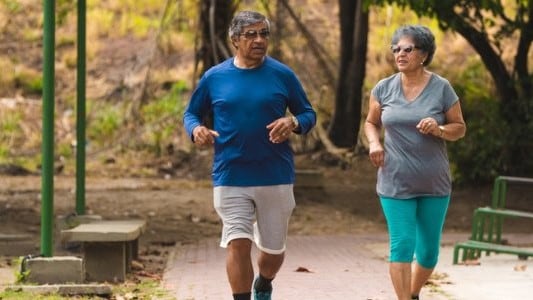Key points
- Regular physical activity provides immediate and long-term health benefits.
- Being physically active can help you maintain a healthy weight.
- How much physical activity you need to maintain a healthy weight varies by individual.

Why it's important
Regular physical activity provides immediate and long-term health benefits. Being physically active can improve your brain health. Other benefits include stronger bones and muscles and better ability to perform everyday activities.
Physical activity also helps:
- Improve sleep quality.
- Reduce high blood pressure and risk of heart disease and stroke.
- Reduce risk of type 2 diabetes.
- Reduce risk of several forms of cancer.
- Reduce arthritis pain and associated disability.
- Reduce risk of osteoporosis and falls.
- Reduce symptoms of depression and anxiety.
In addition, physical activity is important if you are trying to lose weight or maintain a healthy weight. More physical activity increases the number of calories your body uses for energy. Using calories through physical activity, combined with reducing the calories you eat, creates a calorie deficit that results in weight loss.
Most weight loss occurs from decreasing calories. However, the only way to maintain weight loss is to engage in regular physical activity.
How much physical activity do I need?
For overall health, adults need at least 150 minutes a week of moderate-intensity aerobic activity. This could be brisk walking 22 minutes a day; 30 minutes a day, 5 days a week; or what works for your schedule. Alternatively, you could do 75 minutes of vigorous-intensity aerobic activity each week, such as swimming laps. Or you could do an equivalent combination of moderate- and vigorous-intensity aerobic activity each week. Adults also need at least 2 days a week of muscle-strengthening activity. See recommendations for different groups.
You may need more than the recommended minutes of physical activity a week to maintain your weight. The exact amount of physical activity needed to maintain a healthy weight varies greatly from person to person.
To lose weight and keep it off, you will need a high amount of physical activity unless you also adjust your diet to reduce the number of calories you eat and drink. Getting to and staying at a healthy weight requires both regular physical activity and healthy eating patterns.

What do moderate- and vigorous-intensity mean?
With moderate-intensity physical activity, breathing and heart rate are noticeably faster, but you can still carry on a conversation.
Examples include:
- Walking briskly (a 15-minute mile).
- Light yard work (raking/bagging leaves or pushing a lawn mower).
- Light snow shoveling.
- Actively playing with children.
- Biking at a casual pace.
With vigorous-intensity physical activity, your heart rate increases substantially. You are breathing too hard to have a conversation.
Examples include:
- Jogging/running.
- Swimming laps.
- Rollerblading/inline skating at a brisk pace.
- Cross-country skiing.
- Most competitive sports (football, basketball, and soccer).
- Jumping rope.
How many calories are used in typical activities?
The following tables show calories used in common physical activities at both moderate and vigorous levels.
Moderate Physical Activity
Approximate Calories/30 Minutes for a 154 lb Person1
Approximate Calories/Hr for a 154 lb Person1
Hiking
185
370
Light gardening/yard work
165
330
Dancing
165
330
Golf (walking and carrying clubs)
165
330
Bicycling (<10 mph)
145
290
Walking (3.5 mph)
140
280
Weight lifting (general light workout)
110
220
Stretching
90
180
Vigorous Physical Activity
Approximate Calories/30 Minutes for a 154 lb Person1
Approximate Calories/Hr for a 154 lb Person1
Running/jogging (5 mph)
295
590
Bicycling (>10 mph)
295
590
Swimming (slow freestyle laps)
255
510
Aerobics
240
510
Walking (4.5 mph)
230
460
Heavy yard work (chopping wood)
220
440
Weight lifting (vigorous effort)
–
440
Basketball (vigorous)
220
440
1 Calories burned will be higher for persons who weigh more than 154 lbs (70 kg) and lower for people who weigh less. Adapted from Dietary Guidelines for Americans 2005, page 16, Table 4.
